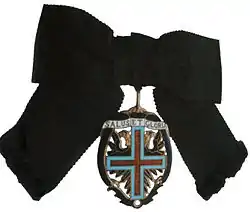Royal Red Cross
The Royal Red Cross (RRC) is a military decoration awarded in the United Kingdom and Commonwealth for exceptional services in military nursing.
| Royal Red Cross | |
|---|---|
.jpg.webp) Badge of the Royal Red Cross .jpg.webp) Badge of an Associate of the Royal Red Cross | |
| Type | Military decoration |
| Awarded for | Exceptional services in military nursing |
| Presented by | United Kingdom |
| Eligibility | Members of the Military Nursing Services |
| Post-nominals | RRC ARRC |
| Established | 27 April 1883 |
Ribbon bar | |
| Order of Wear | |
| Next (higher) | Conspicuous Gallantry Cross (CGC) Air Force Cross (AFC)[1] |
| Next (lower) | Distinguished Service Cross (DSC)[1] Order of Saint John[2] |
Foundation
The award was established on 23 April 1883 by Queen Victoria, with a single class of Member and first awarded to the founder of modern nursing, Florence Nightingale. A second and lower class, Associate, was added during World War I in November 1915.[3]
The award is made to a fully trained nurse of an officially recognised nursing service, military or civilian, who has shown exceptional devotion and competence in the performance of nursing duties, over a continuous and long period, or who has performed an exceptional act of bravery and devotion at her or his post of duty. It is conferred on members of the nursing services regardless of rank. Holders of the second class who receive a further award are promoted to the first class, although an initial award can also be made in the first class. Holders of the first class who receive a further award are awarded a bar.[4]
The decoration was conferred exclusively on women until 1976, when men became eligible, with posthumous awards permitted from 1979.[5]
Recipients of the Royal Red Cross are entitled to use the post-nominal letters "RRC" or "ARRC" for Members and Associates respectively.[6]
Description
- The badge for RRC is in the shape of a golden cross, 1.375 inches (3.49 cm) wide, the obverse enamelled red, with a circular medallion, bearing an effigy of the reigning monarch at its centre. The words "Faith", "Hope" and "Charity" are inscribed on the upper limbs of the cross, with the year "1883" in the lower limb.
The reverse is plain except a circular medallion bearing the royal cypher of the reigning monarch. - The badge for ARRC is in the shape of a silver cross, 1.375 inches (3.49 cm) wide, the obverse enamelled red, with broad silver edges around the enamel; a circular medallion bearing an effigy of the reigning monarch at its centre.
The reverse has a circular medallion bearing the royal cypher of the reigning monarch, with the words "Faith", "Hope" and "Charity" inscribed on the upper three limbs of the cross, with the year "1883" in the lower limb. - The ribbon for both grades is dark blue with crimson edge stripes. The decoration is worn by women from the ribbon in the form of a bow, although it can be worn by both sexes in military uniform on a straight ribbon alongside other medals.
- To recognise further exceptional devotion and competency in the performance of nursing duties or exceptional act of bravery and devotion at her or his post of duty, a bar may be awarded to a recipient of the RRC. The bar is linked to the cross and is made of red enamel. A rosette is worn on the ribbon in undress to denote a bar to the RRC.
See also
- Category:Members of the Royal Red Cross
- British and Commonwealth orders and decorations
References
- "No. 56878". The London Gazette (Supplement). 17 March 2003. p. 3351.
- "JSP 761 Honours and Awards in the Armed Forces" (PDF). p. 12A-1. Retrieved 7 November 2014.
- "No. 29368". The London Gazette. 16 November 1915. p. 11324.
- P E Abbott & J M A Tamplin. British Gallantry Awards. pp. 259-270. Nimrod Dix & Co, London, 1981.ISBN 0-902633-74-0
- P E Abbott & J M A Tamplin. British Gallantry Awards. p. xx. Nimrod Dix & Co, London, 1981.ISBN 0-902633-74-0
- John Mussell (ed). Medal Yearbook 2015. p. 86. Token Publishing Ltd. Honiton, Devon.
External links
| Wikimedia Commons has media related to Royal Red Cross. |

